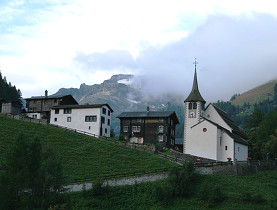Nature park status becomes engine of growth

Economically depressed rural Swiss regions are queuing up to receive a "park of national importance" label - and the government subsidies that go with it.
In the last two years, the total area of the country being set aside as parkland has jumped from 0.4 to 14 per cent (5,750km2). The figure could rise to 20 per cent.
The explosive growth is the result of a new law governing the establishment and operation of parks, the Nature and Cultural Heritage Protection Act, which came into force at the beginning of 2007.
But the law on its own is not enough to explain why nearly 20 regions across the country already have or are bidding for the label. To a great extent, interest has been sparked by the government’s decision to pump money into areas interested in becoming parks and by Switzerland’s bottom-up approach.
The latter aspect means people living in rural zones can decide for themselves if they think their villages and the surrounding countryside have cultural and natural values worth preserving.
Not surprisingly, it has been regions lacking large-scale tourism infrastructure, such as hotel beds and ski lifts, that are seeking the subsidies that come with park status. It could be seen as a last-ditch move to stop cash-strapped mountain villages from dying out.
The scattered villages in and around the Binn Valley in canton Valais are a case in point. They have received SFr680,000 ($636,000) in federal funding over a four-year period to establish a regional nature park.
The accent will be on job preservation – not nature conservation, since large-scale development in the sparsely populated valley has been prohibited since 1964. That was when locals signed a nature protection pact with a leading environmental organisation, Pro Natura, and the Swiss Alpine Club.
Save jobs
During a visit by swissinfo.ch to the village of Binn, locals said they were in a battle to save the few jobs that remain.
The government funding, Binn mayor Beat Tenisch said, would mostly be used to promote the park and market local products like cheese, wood carvings and mountain crystals. In a best case scenario, Tenisch hopes ten new jobs can be created.
Efforts have already been made to improve tourism infrastructure in the valley while maintaining a low impact approach. This includes the restoration of a 19th century hotel, and the introduction of a minibus service to shuttle hikers from the village up to mountain trailheads.
On the conservation side, a stretch of the river running through the valley is being restored to its natural course.
Money talks
While the Binn Valley may get the balance between economic development and nature conservation right, there are concerns people in other regions are only in it for the money.
Otto Sieber of Pro Natura told swissinfo.ch that he thought not enough funding would flow into environmental protection measures.
“Many parks have been sold to the population as if they were only projects for development with no changes needed regarding protection issues,” he said.
Andreas Weissen, manager of the Swiss Parks Network umbrella organisation, admitted that economic interests had overridden other considerations.
Cultural and natural heritage
“The biggest argument to create a park is the economic return, but the concept is to preserve cultural and natural heritage, so development on the scale of big Swiss resorts is not possible,” he said.
“It’s one thing to sell a project, but to get the label you have to prove you have a concept to preserve regional values.”
As an example, Weissen said farmers living within the boundaries of the area destined to become the Chasseral regional park in the western Jura mountains have agreed to stop using chemical fertilisers and pesticides, and only to cut hay after grasses have seeded. Such meadows have greater biodiversity, attracting birds and insects.
Sieber warned however that the people in some parts of the country could turn sour on the parks idea. He said residents living in and around Parc Ela in southeastern Switzerland must decide whether they want to pursue mass tourism or become park stakeholders.
Like Chasseral and Binn Valley, Parc Ela is earmarked to become a regional park in the next couple of years. But Sieber doubts whether the government will grant the label if a large hotel complex with more than 600 beds is built in Savognin, the ski resort bordering the park.
The people of the region voted in favour of the mass tourism project in August.
Dale Bechtel in Binn, swissinfo.ch
The Nature and Cultural Heritage Protection Act (NHG) introduced in 2007 allows for the creation of parks deemed of national importance in three categories. They are: national parks, regional nature parks and nature discovery parks.
While nature is allowed to take its course in a national park with as little human intervention as possible, regional nature parks are partly populated rural areas that have both high natural and cultural values.
As of August 2009, Switzerland had one national park (founded in canton Graubünden in 1914), one nature discovery park (Sihlwald: small reserve near Zurich), two regional nature parks and 14 official candidates for the regional nature park label.
The government is providing SFr5.5 million in funding for existing parks and candidates this year. The amount will rise to SFr10 million from 2012.
Switzerland lags behind many other countries including its European neighbours in the creation of regional parks. Germany, for example, has more than 100 regional nature parks and another dozen national parks, covering a quarter of the country’s landmass.
The Swiss-based International Union for the Conservation of Nature (IUCN) recognises the importance of regional nature parks. These “lived-in landscapes are so important for conservation and sustainable development that they deserve special protection”, the IUCN says.
“As protected areas based on the interactions of people and nature over time, these places sustain biological and cultural diversity.”

In compliance with the JTI standards
More: SWI swissinfo.ch certified by the Journalism Trust Initiative













You can find an overview of ongoing debates with our journalists here . Please join us!
If you want to start a conversation about a topic raised in this article or want to report factual errors, email us at english@swissinfo.ch.